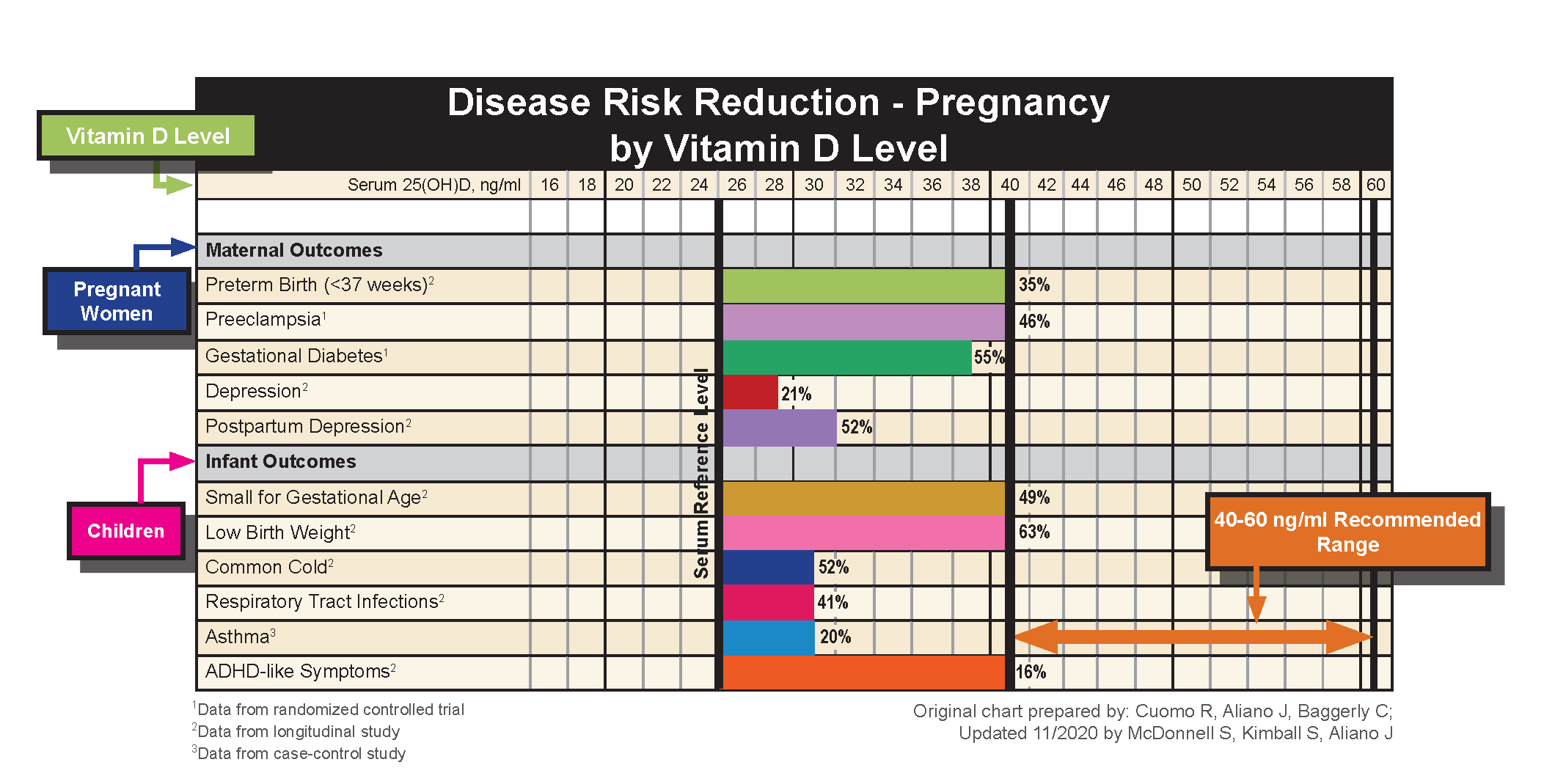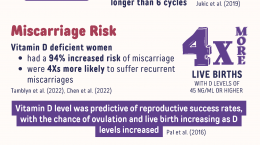Published on December 1, 2020
This updated illustration shows why it is important to ensure vitamin D levels are 40-60 ng/ml (100-150 nmol/L) for a healthy pregnancy and baby
Numerous studies have found that higher vitamin D levels among pregnant women reduce the risk of adverse maternal and infant outcomes. We reviewed and compiled many of these findings to create an updated version of the Pregnancy Disease Risk Reduction Chart below.
Click to Enlarge & Download (ng/ml)
Click to Enlarge & Download (nmol/L)
The Pregnancy Disease Risk Reduction Chart shows the percent lower risk at a given vitamin D level compared to a common reference level of 25 ng/ml (62 nmol/L), which is the approximate average level of the U.S. population. For example, preterm birth risk is reduced by 35% when the serum level is 40 ng/ml (100 nmol/L) compared to the reference level of 25 ng/ml.
Ensuring a vitamin D level in the range of 40-60 ng/ml (100-150 nmol/L) during pregnancy is an effective way to reduce the risk of complications. Do you know your vitamin D level? Take action now to reach your target vitamin D level; start by finding out where your level is at today.
How was this chart created?
 There are many studies that have been published concerning the role of vitamin D in maternal and infant outcomes – some of which report conflicting results. You may ask how we chose the studies we did.
There are many studies that have been published concerning the role of vitamin D in maternal and infant outcomes – some of which report conflicting results. You may ask how we chose the studies we did.
We began by reviewing whether there was a known mechanism for how vitamin D would play a role in each outcome. We then reviewed meta-analyses published in the previous two years because they included the most recent data available. Meta-analyses combine the results of observational studies and/or randomized control trials to determine an overall effect of vitamin D on their outcome of interest. Several meta-analyses have found that vitamin D deficiency is associated with the development of many adverse pregnancy-related conditions and infant outcomes, and that vitamin D supplementation improves those outcomes.
To select studies for the Pregnancy Disease Risk Reduction Chart, we reviewed the trials included in the meta-analyses and studies published after the meta-analyses were reported to identify studies that reported data we could use. The study needed to report statistically significant disease risk reduction in relation to vitamin D levels, more specifically serum 25(OH)D levels. Also, the analysis needed to include vitamin D levels above the reference level of 25 ng/ml (62 nmol/L). Of the identified studies, those selected for the chart had the highest levels of evidence (RCT, longitudinal, then case-control), included participants with the broadest range of vitamin D levels, and had the largest study populations.
Ensure Vitamin D Levels of 40-60 ng/ml (100-150 nmol/L) for You, Your Children, Loved Ones
Correcting a vitamin D deficiency at any age and any time of life decrease potential disease severity and improve outcomes! Test your vitamin D level today, learn what steps to take to improve your level, and take action to achieve and maintain a vitamin D level of 40-60 ng/ml (100-150 nmol/L).
Using the GrassrootsHealth Custom Kit Builder, you can create a test kit that measures your status of vitamin D and other important nutrients (such as omega-3s, zinc and magnesium), as well as your CRP level to measure inflammation. Click here to build and order your test kit today – measure your status and take the steps necessary to improve them if needed; make an impact on your health today and for your future! When you know what your levels are, you can determine next steps to take and how much supplementation may be needed if you are not at your target levels.







